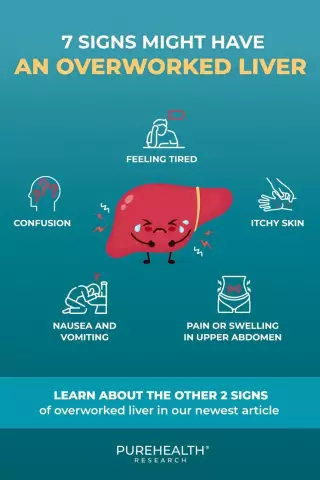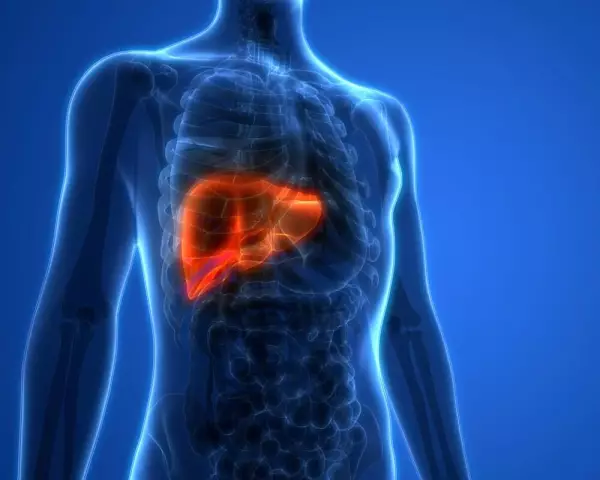- Author Rachel Wainwright [email protected].
- Public 2023-12-15 07:39.
- Last modified 2025-11-02 20:14.
Steatosis

Steatosis, or fatty degeneration of the liver, is a pathological condition in which fat accumulates in hepatocytes in the form of drops. Fat can be formed so much that the hepatocyte ruptures, and the fat accumulates in the intercellular space in the form of fatty cysts that disrupt the structure of the liver.
This is a common disease that can occur even in childhood, but people are most susceptible to it after 45 years, women more often than men suffer from non-alcoholic steatosis, men - steatosis, which has developed as a result of alcoholism. Liver steatosis can be an independent pathology, or a symptom of some other primary diseases (for example, type 2 diabetes mellitus).
Causes of steatosis
There are two main causes of liver steatosis. This is excessive alcohol consumption, and a violation of fat-carbohydrate metabolism. Currently, non-alcoholic hepatic steatosis is predominant. The development of non-alcoholic steatosis is associated with excessive intake of fat into the body, very often people with obesity suffer from it.
There is evidence of the influence of genetic factors on the development of liver steatosis - its risk increases if the family has cases of steatosis, diabetes mellitus, obesity to a large extent.
Steatosis can develop under the influence of certain long-term medications (medicinal hepatic steatosis), such as tetracycline antibiotics, corticosteroids, and cytostatic drugs.
Symptoms of steatosis

Steatosis is a disease that develops for a long time, it is characterized by a slow, chronic form of the course. Symptoms of steatosis may be absent altogether, in this case it is discovered by chance, during a medical examination for another reason. The most common symptoms of steatosis are weakness, nausea, an enlarged liver, and a feeling of heaviness and compression in the right hypochondrium. Spontaneous pain in the right hypochondrium may appear. Another symptom of steatosis is susceptibility to colds and other infections due to decreased immunity. Steatosis can lead to disturbances in the outflow of bile, in this case, symptoms of cholestasis (stagnation of bile) join the symptoms of steatosis: yellowness of the skin, itching, intense pain in the right hypochondrium, nausea and vomiting with an admixture of bile.
Development, stages and complications of steatosis
Liver steatosis develops when there is an excessive intake of fat in the liver cells. Initially, the process involves single hepatocytes (disseminated fatty hepatosis), then groups of liver cells (zonal obesity), then steatosis covers the entire liver tissue (diffuse obesity). Fat accumulates in the hepatocyte, then the fat drop increases so much that it ruptures the hepatocyte, resulting in the formation of a fat cyst. A fatty cyst affects the surrounding liver tissue, causing a mesenchymal-cellular reaction, which leads to the thickening of the tissue around the cyst and its degeneration into fibrous tissue. This is the onset of liver cirrhosis, a condition that can be fatal.
The following stages of steatosis are distinguished:
- Simple obesity. Fat accumulates inside the hepatocyte, hepatocytes are intact;
- Obesity, combined with necrobiosis of hepatocytes. Fat cysts are formed in the liver tissue, there is a mesenchymal-cellular reaction;
- Precirrhotic stage. Around the fatty cysts, areas of growth of connective tissue are formed, disrupting the structure of the liver.
Diagnosis of steatosis
Diagnosing steatosis can be challenging, as laboratory tests often fail to show changes that are characteristic of liver inflammation. A preliminary diagnosis can be made on the basis of the symptoms of steatosis, taking into account the history data (obesity, diabetes mellitus, alcoholism).
To confirm the diagnosis, computed tomography or magnetic resonance imaging is performed, the final diagnosis can be confirmed only after taking a targeted biopsy under the control of computed tomography. The detection of drops of fat, as well as areas of fibrous tissue, serves as a diagnostic sign of liver steatosis.
Treatment of steatosis

Treatment of steatosis consists in eliminating the cause that caused fatty degeneration of the liver and normalizing metabolism.
With an exacerbation of steatosis, treatment is carried out in a hospital. Bed rest, drug therapy and diet therapy are prescribed. After the acute symptoms subside, the patient is discharged home, and the treatment of steatosis is carried out on an outpatient basis.
Since the disease is associated with excess fat intake, diet plays a critical role in the treatment of steatosis. The fat content is sharply limited, preference is given to dairy and vegetable food, special attention is paid to a sufficient amount of easily digestible protein. It is recommended to take food fractionally, in small portions. The patient must follow a sparing regimen, with limited physical and emotional-mental stress. Outside the exacerbation phase, non-burdensome physical education is recommended, contributing to the normalization of metabolism.
The medical treatment of steatosis consists in the appointment of a long course of lipotropic (fat-breaking) drugs: vitamin B 12, lipoic acid, methionine, essential, anabolic steroid drugs, etc.
Physiotherapeutic effects are also used: ozone therapy, stay in a pressure chamber, ultrasound.
In general, the treatment of steatosis is usually successful, and the reverse development of the process occurs quite quickly after the start of effective therapy. The exception is stage 3 hepatic steatosis, in which connective tissue is formed in the liver parenchyma. This stage of steatosis is irreversible, however, vigorous therapeutic measures and elimination of the damaging factor, as well as strict adherence to medical prescriptions, can stop the further degeneration of the liver and the development of cirrhosis.
YouTube video related to the article:
The information is generalized and provided for informational purposes only. At the first sign of illness, see your doctor. Self-medication is hazardous to health!






